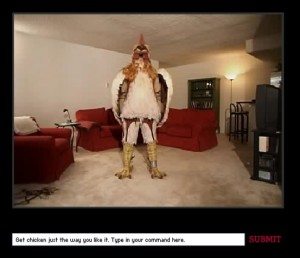I’m going to talk to you about storytelling because as a marketer, I see that consumers’ expectations are changing, they’re becoming more demanding. The days of advertising that yells a message through the television and expects the audience to act simply because there is a sale, are gone.
Successful marketing and advertising has always been about finding the balance of the right offer, put in front of the right customer through the right medium, at the right time. But even that isn’t enough anymore. We marketers and brand advertisers have to be able to make an emotional connection with our intended audience, we have to first get their attention and cut through the clutter. Then we have to tell them a story and that story has to be compelling. The message has to engage them enough to be remembered later (brand recall) and influence them (create purchase intent) to act, or at the very least, consider acting.

The art of storytelling - Burger King's Subservient Chicken was the original viral online ad - allowing the audience to co-create the story and immerse themselves in the experience
Frank Rose is an expert in story-telling. Unfortunately for Frank, he’s not the best orator in the world and sometimes his story gets lost because he lacks the on-stage presence (or confidence) to retain his audience’s attention. However, what Frank Rose has to teach us marketers about storytelling in advertising is important. He talked about how story tellers like to have control over the story but that perceptions are changing.
Audiences and marketers are now co-creating the story (through social media and interactive “choose your own adventure” campaigns I assume) and the internet has raised the question, “Who is really telling the story?” If we give people the tools, they will create their own ads – think of online campaigns such as Burger King’s Subservient Chicken or Old Spice’s The Man Your Man Could Smell Like. In these interactive campaigns, the user can interact with the advertising and get an immediate response.
Frank Rose also reminded us of creative storytellers like Quentin Tarrantino and Guy Ritchie who prove that a story doesn’t have to be linear, it can be chaotic and immersive.
We’ve been trained the think that stories are to be passively consumed but technology has changed that. We, the audience, can become part of the story. Frank Rose gave an example of the TV series LOST (which I was never a fan of), where the audience started to congregate online to discuss the plot. One fan was so engaged in the story that he created the LOST Pedia – an anthology of facts from the show so that people could keep track of the past storylines. The show was so complicated that from time to time the show’s writers had to consult the LOST Pedia when they lost track of their own story. Audiences were so engaged and vocal of their opinions of the LOST story that they were able to influence the fate of characters who were unpopular.
These are many examples of stories that have crossed over from having a traditional author to becoming community property. When the audience become custodians and co-creators of the story, you know you’ve made an emotional connection and that your brand and message will be remembered. This is the holy grail of online advertising. To be responsible for a campaign that truly goes viral and is taken over by the movement.
The funny thing is, that this is not a new phenomenon. Throughout history, storytelling was a participatory event, it had to be because most of the audience could not read. So we really are coming full circle and technology has enabled storytelling to resurface in its purest form and I’m delighted.
